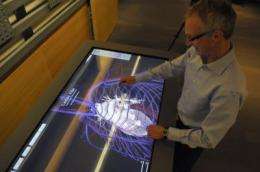LINDSAY: The future of medical education

Researchers at the University of Calgary have created a new, interactive tool that will change the way medical education is taught.
LINDSAY, named after Dr. Lindsay Kimmett, a bright, promising medical student who died in a car crash, is a virtual human that uses a variety of touch interfaces to help students learn anatomy and physiology in 3D.
"There's a real gap between textbook anatomy and what students see in real life - the LINDSAY software connects the dots between the classroom and real life," says Heather Jamniczky, assistant professor in the Faculty of Medicine who uses the software to teach classes.
"Students have been really enthusiastic and it seems to improve their ability to make the connections we are asking. It pulls everything in and provides a much more engaging learning experience."
The project is a collaboration between the faculties of Medicine and Science and can be customized to whatever lesson students are being taught.
"It's sort of the medical equivalent to a flight simulator," says Professor Christian Jacob of the Faculty of Science, whose team helped design the software. "Students can navigate – actually fly – through the body to see what is going on at different levels of scale, from inside a cell to a pumping heart."
Dr. Bruce Wright, associate dean of undergraduate medical education, says he hopes LINDSAY will revolutionize how teaching is done in the classroom. The software can be used on big screens as well as on other devices such as the iPad, iPhone and smartboards. Those who teach can also use another application called LINDSAY presenter to make 3D slides and soon, the software will become available to download as an app.
"In five years from now, I want LINDSAY to be a one-stop shop where students can learn all aspects of the anatomy and physiology," says Wright. "This isn't just a tool to be used in medical school. It's part of our vision to go beyond the practise of medicine and into other subjects. The software is dynamic and robust and can be set up anywhere learning needs to happen. In fact, a high-school biology class in Cochrane is using the software."
Lindsay's parents Dianne and Kelly Kimmett say they are thrilled with the project that has her name attached to it. "This is something that Lindsay would have loved," says Dianne Kimmett. "She would have been absolutely inspired by the 21 Century teaching tool it has become."
More information: lindsayvirtualhuman.org/


















